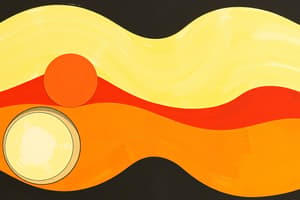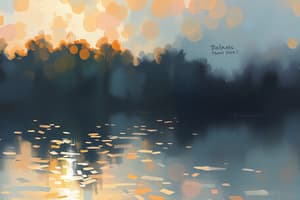Podcast
Questions and Answers
What is the primary concern of texture in art?
What is the primary concern of texture in art?
- Color and composition
- Surface quality or 'feel' (correct)
- Light and shadow
- Shape and form
What type of texture is experienced through touch?
What type of texture is experienced through touch?
- Smooth texture
- Tactile texture (correct)
- Visual texture
- Rough texture
Which element of texture can evoke feelings of discomfort or unease?
Which element of texture can evoke feelings of discomfort or unease?
- Luminosity
- Pattern
- Smoothness
- Roughness (correct)
What artistic technique builds up thick layers of paint to create a raised, three-dimensional texture?
What artistic technique builds up thick layers of paint to create a raised, three-dimensional texture?
Which artistic movement emphasized visual texture through loose, expressive brushstrokes?
Which artistic movement emphasized visual texture through loose, expressive brushstrokes?
What is the term for a texture that is even, flat, or polished?
What is the term for a texture that is even, flat, or polished?
What is the term for repeated designs or motifs that create a visual texture?
What is the term for repeated designs or motifs that create a visual texture?
What artistic technique applies multiple thin layers of transparent paint to achieve a smooth, luminous texture?
What artistic technique applies multiple thin layers of transparent paint to achieve a smooth, luminous texture?
What is the term for combining different materials to create a textured surface?
What is the term for combining different materials to create a textured surface?
What is the primary difference between visual and tactile texture?
What is the primary difference between visual and tactile texture?
Flashcards are hidden until you start studying
Study Notes
Texture
Definition: Texture refers to the surface quality or "feel" of an artwork, whether it is visual or tactile.
Types of Texture:
- Visual Texture:
- Creates the illusion of texture through visual cues, such as patterns, shapes, and colors.
- Can be achieved through various techniques, like brushstrokes, layering, or printing.
- Tactile Texture:
- A physical quality that can be experienced through touch.
- Found in three-dimensional artworks, like sculptures, ceramics, or textiles.
Elements of Texture:
- Roughness:
- A texture that is coarse, uneven, or jagged.
- Can evoke feelings of discomfort or unease.
- Smoothness:
- A texture that is even, flat, or polished.
- Can convey a sense of calmness or serenity.
- Pattern:
- Repeated designs or motifs that create a visual texture.
- Can add depth, interest, or rhythm to an artwork.
Artistic Techniques for Creating Texture:
- Impasto:
- Building up thick layers of paint to create a raised, three-dimensional texture.
- Glazing:
- Applying multiple thin layers of transparent paint to achieve a smooth, luminous texture.
- Collage:
- Combining different materials, like paper, fabric, or found objects, to create a textured surface.
Artistic Movements Associated with Texture:
- Impressionism:
- Emphasized visual texture through loose, expressive brushstrokes.
- Abstract Expressionism:
- Focused on tactile texture through the use of thick, heavy paint and unconventional materials.
- Surrealism:
- Often incorporated unusual textures, like fabric or paper, to create dreamlike or unsettling environments.
Studying That Suits You
Use AI to generate personalized quizzes and flashcards to suit your learning preferences.




